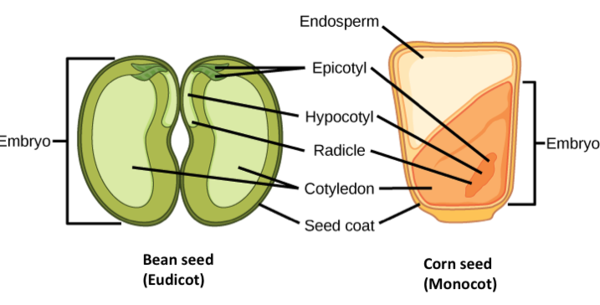| << Chapter < Page | Chapter >> Page > |
The mature ovule develops into the seed. A typical seed contains a seed coat, cotyledons, endosperm, and a single embryo ( [link] ).

The storage of food reserves in angiosperm seeds differs between monocots and eudicots. In monocots, such as corn and wheat, the single cotyledon is connected directly to the embryo via vascular tissue (xylem and phloem). Food reserves are stored in the large endosperm. Upon germination, enzymes are secreted by the aleurone, a single layer of cells just inside the seed coat that surrounds the endosperm and embryo. The enzymes degrade the stored carbohydrates, proteins and lipids, the products of which are absorbed by the cotyledon and transported to the developing embryo. Therefore, the cotyledon can be seen to be an absorptive organ, not a storage organ.
The two cotyledons in the eudicot seed also have vascular connections to the embryo. In endospermic eudicots, the food reserves are stored in the endosperm. During germination, the two cotyledons therefore act as absorptive organs to take up the enzymatically released food reserves, much like in monocots (monocots, by definition, also have endospermic seeds). Tobacco ( Nicotiana tabaccum ), tomato ( Solanum lycopersicum ), and pepper ( Capsicum annuum ) are examples of endospermic eudicots. In non-endospermic eudicots, the triploid endosperm develops normally following double fertilization, but the endosperm food reserves are quickly remobilized and moved into the developing cotyledon for storage. The two halves of a peanut seed ( Arachis hypogaea ) and the split peas ( Pisum sativum ) of split pea soup are individual cotyledons loaded with food reserves.
The seed, along with the ovule, is protected by a seed coat that is formed from the integuments of the ovule sac. The embryo consists of three parts: the plumule, the radicle, and the hypocotyl. The portion of the embryo between the cotyledon attachment point and the radicle is known as the hypocotyl (hypocotyl means “below the cotyledons”). The embryo terminates in a radicle (the embryonic root), which is the region from which the root will develop. In eudicots, the hypocotyls extend above ground, giving rise to the stem of the plant. In monocots, the hypocotyl does not show above ground because monocots do not exhibit stem elongation. The part of the embryonic axis that projects above the cotyledons is known as the epicotyl . The plumule is composed of the epicotyl, young leaves, and the shoot apical meristem.
Upon germination in eudicot seeds ( [link] ), the epicotyl is shaped like a hook with the plumule pointing downwards. This shape is called the plumule hook, and it persists as long as germination proceeds in the dark. Therefore, as the epicotyl pushes through the tough and abrasive soil, the plumule is protected from damage. Upon exposure to light, the hypocotyl hook straightens out, the young foliage leaves face the sun and expand, and the epicotyl continues to elongate. During this time, the radicle is also growing and producing the primary root. As it grows downward to form the tap root, lateral roots branch off to all sides, producing the typical eudicot tap root system.

Notification Switch
Would you like to follow the 'Principles of biology' conversation and receive update notifications?